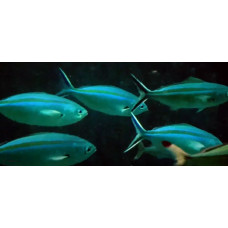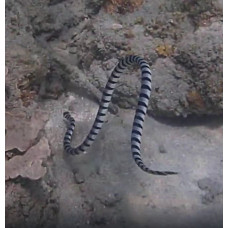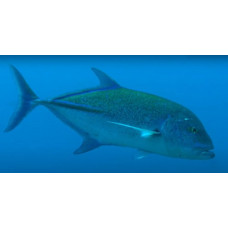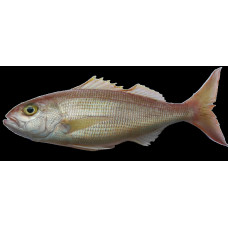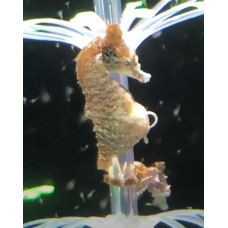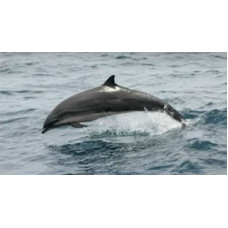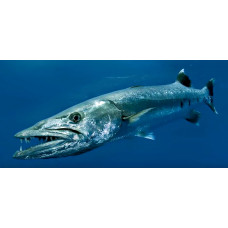Fauna of the Fiji Sea
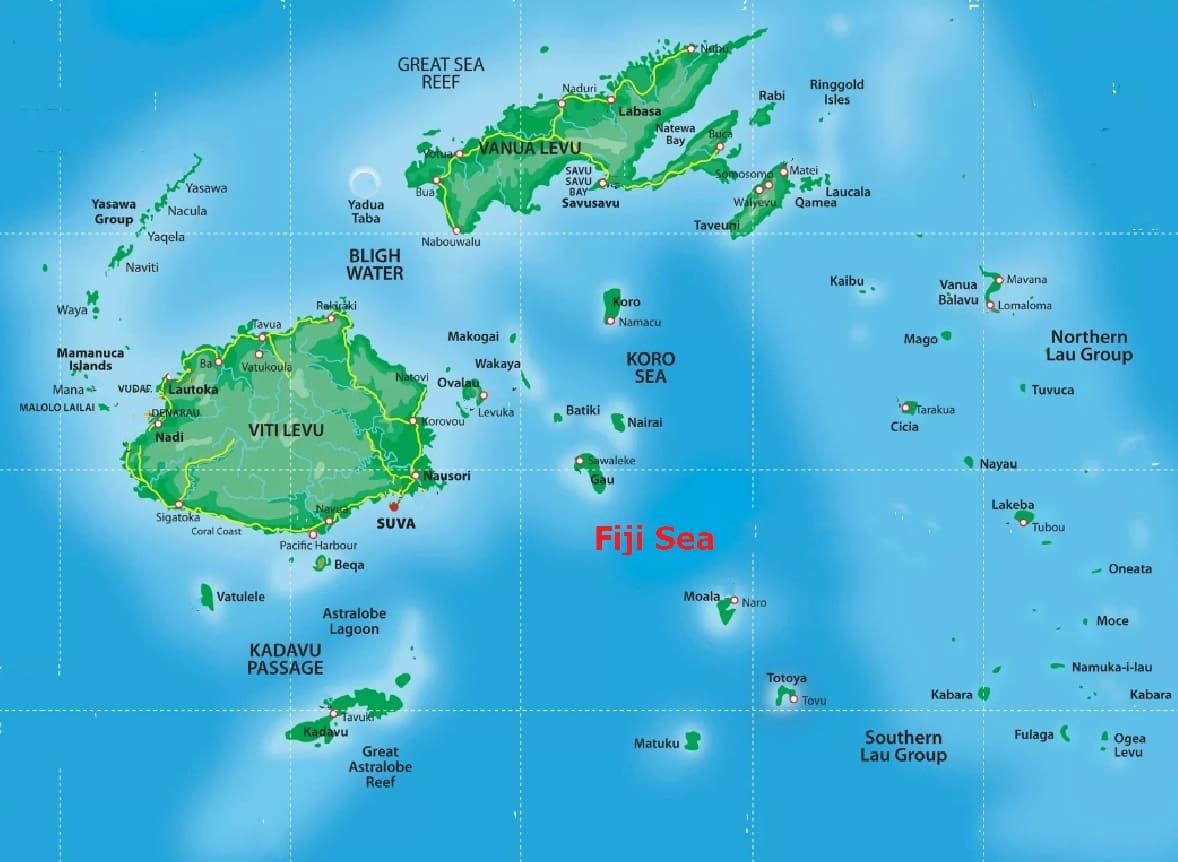 An inter-island sea in the southwest Pacific Ocean. It is bounded to the north by the Fiji Islands, to the east by the Kermadec Islands, to the south by New Zealand and the Tasman Sea, and to the west by the Coral Sea. The area is 3177 thousand km². The average depth is 2740 m, the maximum is 7633 m. Surface water temperature from 18-23 °C in the southeast to 25-28 °C in the north. Salinity 34.9-35.5 ‰. Bottom relief is complex, with submarine ridges and volcanoes. Semidiurnal tides range from 1.5 to 3.0 m.
An inter-island sea in the southwest Pacific Ocean. It is bounded to the north by the Fiji Islands, to the east by the Kermadec Islands, to the south by New Zealand and the Tasman Sea, and to the west by the Coral Sea. The area is 3177 thousand km². The average depth is 2740 m, the maximum is 7633 m. Surface water temperature from 18-23 °C in the southeast to 25-28 °C in the north. Salinity 34.9-35.5 ‰. Bottom relief is complex, with submarine ridges and volcanoes. Semidiurnal tides range from 1.5 to 3.0 m.
Marine life of Fiji Sea
Fiji's sea is close to the equator, so the water temperature is high all year round. The straits between the islands are home to a wide variety of coral reefs. The most common inhabitants are rays, conger eels, sea turtles and many sea snakes. The open waters are home to marlin, swordfish, sailfish, mackerel, tuna and caranx. Coastal waters abound with tropical fish species, crabs, shrimp, sea cucumber. In the local waters you can find: tridacna, seahorse, sea anemone, crinoid.
Dangerous Sea Creatures of Fiji
Fiji's most dangerous animals include sharks, scorpionfish and cone snails, all of which can inflict painful bites that can be fatal. Stay away from the blue-lipped sea krait, which has a venom 20 times stronger than land snakes; the red lionfish, which has poisonous spines; the saltwater crocodile, the most dangerous animal on the islands; and the box jellyfish, which has tentacles up to 10 feet long.
Mammals of the Fiji Sea
The humpback whale is an endangered species in the Fiji Islands. There are a total of 15 species of mammals in the area. Among them: Dwarf minke whale, Bryde's whale, Fin whale, Pygmy blue whale, Sperm whale, Pygmy sperm whale, Blainville's beaked whale, Ginkgo-toothed beaked whale, Hector's beaked whale, Pantropical spotted dolphin, Fraser's dolphin, Pygmy killer whale.
Sharks of the Fiji Sea
If you are lucky, you can swim in the company of a hammerhead shark. The more dangerous whale shark and tiger shark occasionally come for a treat. But it is rare to see them in local waters, especially close to shore. Large schools of bull sharks, silvertip sharks, nurse sharks and lemon sharks often gather at feeding areas. Gray reef sharks, whitetip reef sharks and leopard sharks can also be seen.
Diving in the Fiji Sea
There is a large coral reef in the Fiji Sea. It is mostly made up of soft corals, but there are also hard corals. In total, more than 400 species of corals have been recorded. In the fantastic coral forests live small exotic invertebrates, leaf scorpionfish, roughsnout ghost pipefish, blue and gold fusiliers and dwarf seahorse, and on the soft corals and actinia themselves live unusual shrimps and crabs. The reefs are very rich in fluted giant clams with colorful mottled shells. There is a high probability of encountering spotted ratfish. Pelagic fish are few. But there is no shortage of giant fish. In the water area you can see giant oceanic manta ray, mottled eagle ray, marbled electric ray, ribbon eel, zebra moray, giant humphead wrasse and great barracuda.
Fishing in the Fiji Sea
The best known and most abundant fish in the reefs of the Fiji Islands is the Mahi-mahi, which can be caught all year round. Blue Marlin, Narrow-barred Spanish Mackerel, Wahoo, Crevalle Jack and Bluefin Trevally are also year-round fish. The warm months from early May to late summer are ideal for skipjack tuna and from April to July for yellowfin tuna. Black marlin are caught from July to November. Dogtooth tuna should be pursued in July. The most popular and interesting fishing is for the large fish dorado. Pacific cod and Chilean jack mackerel, which live closer to shore, are easy to catch. The main delicacy for fishermen and tourists is the crimson jobfish.
Black marlin
Latin nameIstiompax indicaOther namesIstiompax indicaIdentificationThe body is elongated, not strong..
Blue and gold fusilier
Latin nameCaesio caerulaureaOther namesBlue fusilier, gold-band fusilier or scissor-tailed fusili.Id..
Blue-lipped sea krait
Latin nameLaticauda laticaudataOther namesBlue-banded sea krait, common sea kraitIdentificationAbdom..
Bluefin trevally
Latin nameCaranx melampygusOther namesBluefin jack, bluefin kingfish, bluefinned crevalle, blue ulua..
Chilean jack mackerel
Latin nameTrachurus murphyiOther namesInca scad, peruvian jack mackerel.IdentificationThey have an e..
Crabs
An infraorder of ten-legged crustaceans living in salt and fresh water.Crabs (Brachyura) are short-t..
Crimson jobfish
Latin namePristipomoides filamentosusOther namesRosy snapper, bluespot jobfish, crimson snapper, kin..
Dogtooth tuna
Latin nameGymnosarda unicolorOther namesWhite tunaIdentificationThey are elongated, somewhat compres..
Dwarf seahorse
Latin nameHippocampus zosteraeOther namesHippocampus zosteraeIdentificationThere are often small sk..
Eel, American Conger
Latin name Conger oceanicus Other names Conger, dog eel, sea eel, silver eel; French: congre d’Am..
Fraser's dolphin
Latin nameLagenodelphis hoseiOther namesSarawak dolphinIdentificationThe skull is similar to that of..
Giant oceanic manta ray
Latin nameMobula birostrisOther namesGiant manta ray, oceanic manta ray.IdentificationHuge pectoral ..
Gilt-head bream
Latin nameSparus aurataOther namesDorado (Spanish).IdentificationBody oval, torso flattened at the s..
Great barracuda
Latin nameSphyraena barracudaOther namesSphyraena barracudaIdentificationCharacteristic of this fish..
Grey reef shark
Latin nameCarcharhinus amblyrhynchosOther namesGray reef sharkIdentificationThe body of the fish is ..


